The AMD Radeon R9 Nano Review: The Power of Size
by Ryan Smith on September 10, 2015 8:00 AM ESTCompute
Shifting gears, we have our look at compute performance.
Starting us off for our look at compute is LuxMark3.0, the latest version of the official benchmark of LuxRender 2.0. LuxRender’s GPU-accelerated rendering mode is an OpenCL based ray tracer that forms a part of the larger LuxRender suite. Ray tracing has become a stronghold for GPUs in recent years as ray tracing maps well to GPU pipelines, allowing artists to render scenes much more quickly than with CPUs alone.
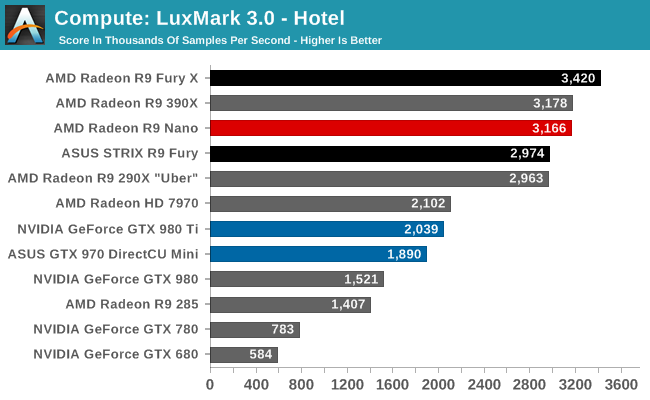
LuxMark ends up being a great corner case for where having a fully enabled Fiji GPU is more important than having the highest clockspeeds. With the R9 Nano able to flirt with its full 1000MHz clockspeed here, the card is able to pass the R9 Fury here. The only thing stopping it from taking the second-place spot is the R9 390X, as Hawaii still sees strong performance here even with fewer SPs.
For our second set of compute benchmarks we have CompuBench 1.5, the successor to CLBenchmark. CompuBench offers a wide array of different practical compute workloads, and we’ve decided to focus on face detection, optical flow modeling, and particle simulations.
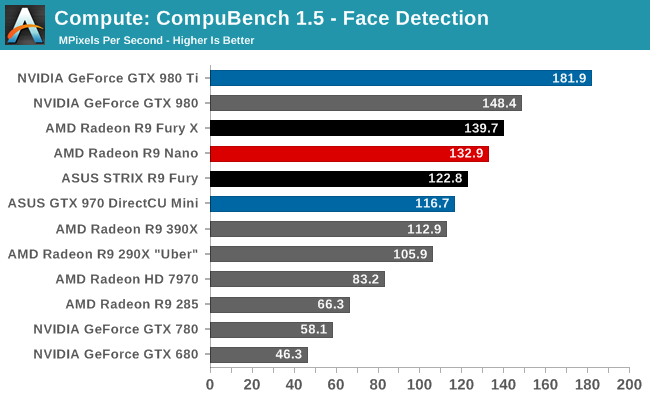
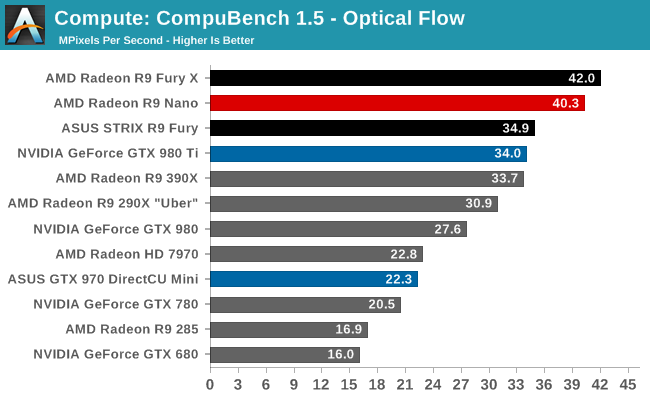
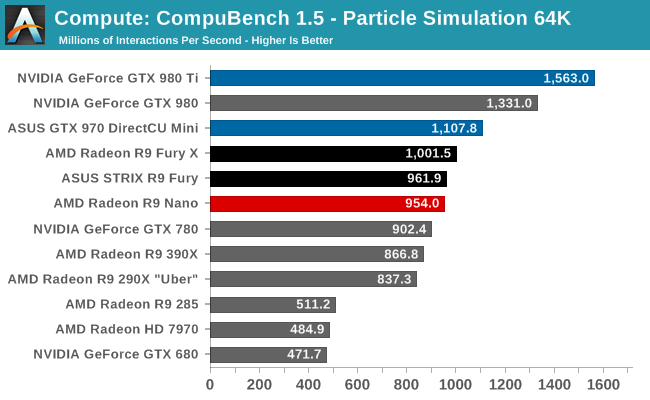
CompuBench provides us another case of where the R9 Nano ends up outpacing the R9 Fury. As a result AMD’s latest card tends to perform somewhere between an R9 Fury and R9 Fury X, with all of the strengths and weaknesses that come from that. This puts the R9 Nano in a good place for Optical Flow, while it will still trail NVIDIA”s best cards under Face Detection and the 64K particle simulation.
Meanwhile it’s interesting to note that AMD’s particle sim scores have significantly improved in the recent drivers. GCN 1.2 cards have seen 20%+ performance improvements here, which may point to some new OpenCL compiler optimizations from AMD.
Our 3rd compute benchmark is Sony Vegas Pro 13, an OpenGL and OpenCL video editing and authoring package. Vegas can use GPUs in a few different ways, the primary uses being to accelerate the video effects and compositing process itself, and in the video encoding step. With video encoding being increasingly offloaded to dedicated DSPs these days we’re focusing on the editing and compositing process, rendering to a low CPU overhead format (XDCAM EX). This specific test comes from Sony, and measures how long it takes to render a video.
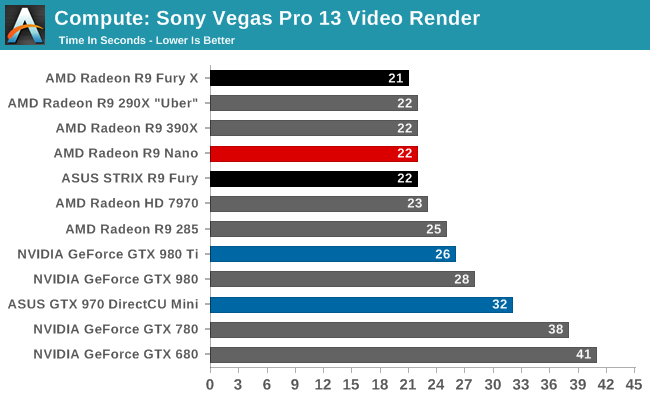
With Vegas there are no surprises; the R9 Nano ties the R9 Fury.
Moving on, our 4th compute benchmark is FAHBench, the official Folding @ Home benchmark. Folding @ Home is the popular Stanford-backed research and distributed computing initiative that has work distributed to millions of volunteer computers over the internet, each of which is responsible for a tiny slice of a protein folding simulation. FAHBench can test both single precision and double precision floating point performance, with single precision being the most useful metric for most consumer cards due to their low double precision performance. Each precision has two modes, explicit and implicit, the difference being whether water atoms are included in the simulation, which adds quite a bit of work and overhead. This is another OpenCL test, utilizing the OpenCL path for FAHCore 17.

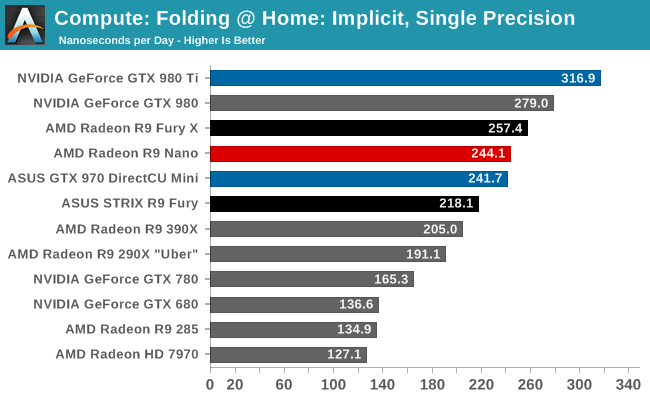
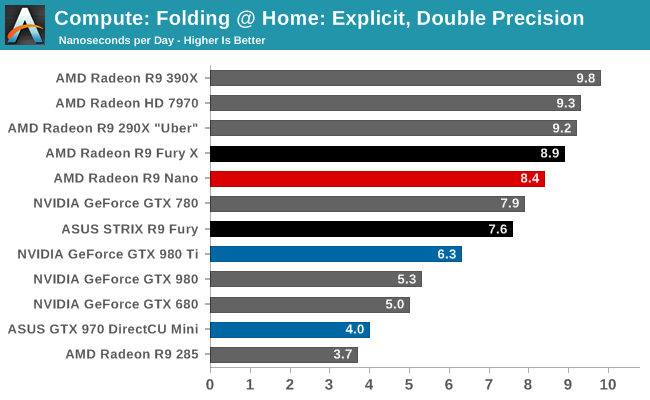
Much like CompuBench and LuxMark, the R9 Nano punches above its weight here. The lack of a graphics workload – and resulting demands on graphics hardware like the ROPs – means most of the card’s power can be allocated to the shaders, allowing higher clockspeeds. This gives the Nano a boost in this situation to bring it much closer to the Fury X, though as far as Folding goes AMD will still trail NVIDIA’s best cards.
Wrapping things up, our final compute benchmark is an in-house project developed by our very own Dr. Ian Cutress. SystemCompute is our first C++ AMP benchmark, utilizing Microsoft’s simple C++ extensions to allow the easy use of GPU computing in C++ programs. SystemCompute in turn is a collection of benchmarks for several different fundamental compute algorithms, with the final score represented in points. DirectCompute is the compute backend for C++ AMP on Windows, so this forms our other DirectCompute test.

Our final test sees the R9 Nano brought back to its place behind the R9 Fury, as the C++ AMP sub-tests are strenuous enough to cause more significant clockspeed throttling. Even behind the R9 Fury the R9 Nano does well for itself here, coming in behind the GTX 980 Ti and head of the R9 390X and GTX 980.










284 Comments
View All Comments
gw74 - Thursday, September 10, 2015 - link
there is no evidence or reason to believe the 3.5GB was anything but an honest mistake, and it was all handled admirably by Nvidia once discovered.You are not the arbiter of what is and is not dead to me, and your condescending attempt to explain its consequences to me is not required.
The point about AMD is that their actions reveal untrustworthiness. Buying a product from someone untrustworthy can have all sorts of negative consequences, whatever the apparent quality or value at the time of purchase.
Pipe down. Have a seat. Have a Diet Coke.
RussianSensation - Thursday, September 10, 2015 - link
"there is no evidence or reason to believe the 3.5GB was anything but an honest mistake, and it was all handled admirably by Nvidia once discovered."Yes, the engineers accidentally designed the card with 3.5GB of VRAM and gimped ROPs. Sure, it was just an accident. Not only that, after it was found out, NV didn't change the specifications for ROPs and VRAM on the boxes of newly produced GTX970 cards. GTX970 doesn't have full speed GDDR5 memory and doesn't have the full stack of ROP performance of GTX980 card. Therefore, it's not a true 4GB GDDR5 card because the last 0.5GB operate at only 28GB/sec which is basically useless.
"and it was all handled admirably by Nvidia once discovered."
NV did absolutely nothing. They showed 0 remorse. It was AIBs that accepted returns. NV didn't provide a return program for existing customers, didn't offer discount coupons for future NV GPUs, they didn't offer a game coupon, they literally did nothing. In fact, they tried to cover it under the rug with PR mouthpieces from sites like PCPerspective how 3.5GB of VRAM doesn't matter.
"The point about AMD is that their actions reveal untrustworthiness. Buying a product from someone untrustworthy can have all sorts of negative consequences, whatever the apparent quality or value at the time of purchase."
What so untrustworthy about AMD's Nano or AMD's graphics cards? The Nano beats GTX970 mini by at least 30%, just like AMD stated. AMD never aimed or claimed to have the Nano being a price/performance king.
gw74 - Thursday, September 10, 2015 - link
This has nothing to do with engineering, the mistakes were in marketing. Nvidia self-evidently showed remorse by admitting and correcting the mistakes and facilitating refunds with retailers. Nvidia don't produce reference 970s, the drop-in card manufacturers do, so which boxes do you mean?For what is untrustworthy try reading my comments.
Oxford Guy - Thursday, September 10, 2015 - link
You should read his rebuttal since clearly you didn't.gw74 - Friday, September 11, 2015 - link
who should read who's rebuttal?RussianSensation - Thursday, September 10, 2015 - link
@gm74,Even if you state that marketing is 100% at fault, which is hard to believe, NV is still responsible for how the product is marketed after the facts came out. It was AIBs that agreed to accept the cards back, not Nvidia. It would be akin to AT&T or Verizon accepting returns of flawed Blackberry phones but Blackberry not offering any refunds directly. NV never offered direct refunds, never issues any game vouchers or discounts as remorse. Stating online that the are sorry does nothing. It's empty PR.
The way professional companies deal with mistakes is completely different than how NV handles it. After the disastrous Bumpgate scandal, the way they treated GTX970 fiasco is shockingly poor.
Mazda after they made a mistake:
"Mazda is offering to buy back most of the 3,551 RX-8 rotary-engine sports cars sold since the July launch because engine power is as much as 5% less than advertised — an important difference to sports car enthusiasts.
Those who tell Mazda they will keep their cars get free scheduled maintenance for the four-year, 50,000-mile warranty period, plus $500."
http://usatoday30.usatoday.com/money/autos/2003-09...
What did Nvidia do in particular for GTX970 owners? Nothing, 0, zilch, nada.
You state that NV isn't responsible for what goes on the marketing boxes of its AIBs? Are you serious. So after NV was caught lying about specifications, did it tell its AIBs to change the specs on their newly printed boxes? If not, they are still lying to consumers and they are OK with AIBs misrepresenting the data.
Kutark - Thursday, September 10, 2015 - link
Im not going to get into the whole debate, but since we're clearly being pedantic here. It was a 4gb card. It absolutely has 4gb of vram. They never advertised it as "4gb (but with .5gb of slower ram!)", so if you want to get on them for that, go for it. But claiming its a 3.5 gb card when it *is* a 4gb card is just as ridiculous as any of the other assertions you're getting on him for making.Oxford Guy - Friday, September 11, 2015 - link
You're not being pedantic. You're being wrong. A lie of omission is a form of lie. 28 GB/s VRAM performance, half that of a midrange card from 2007, is NOT a reasonable expectation for an enthusiast-level card or even any card with DDR5.gw74 - Friday, September 11, 2015 - link
it's not a lie of omission.anubis44 - Thursday, October 8, 2015 - link
Of course it's a misrepresentation. Nobody who reads '4GB' will assume that the last .5GB is so slow that it's essentially necessary to limit game textures to 3.5GB or the game will be suddenly stuttering and the card will be brought to its knees. Give me a break. That's like me marketing a gold bar as 1KG of 'pure gold', but in fact, it's only 750grams of 24K gold, and 250 grams of 10K gold. It's willfully and deliberately deceptive, and if you don't say so, you're complicit in their scam.